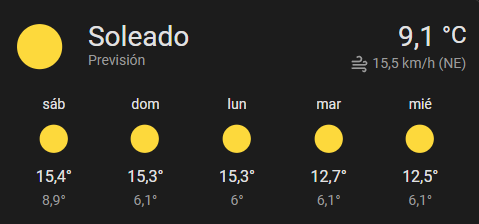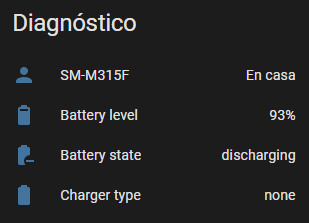.webp)
Home Automation: A Quick Guide to Turning Your House into the Home of the Future. Part 4: Home Assistant Integrations and Features
January 29, 2025 - Reading time: 8 minutes
[Have you read part 1 of this guide? Click here to start from the beginning!]
And we end this "little" "quick" guide to home automation by touching on something basic but with a lot of potential: the functions of Home Assistant itself. This software has various options that will make our lives easier, and some of them end up being quite useful. In addition, we can use various integrations that will provide us with a certain added value to our home automation center.
Integrations
Home Assistant allows us to add all kinds of devices through integrations: cameras, sensors, routers, stoves... but it also has purely software integrations. One that it brings by default is the weather forecast, which although it is not very advanced, gives enough information to know what awaits us in the coming days. If that does not seem enough for you, you can always add one of the many that there are, and feel totally like the weatherman.

There are more playful integrations, such as the possibility of controlling your Minecraft server through a simple panel. You can turn the machine on and off, see how many players are connected... it's a very niche module, but I'm sure it'll be useful to someone.
On the other hand, there are integrations of an informative nature, such as news, football results or Formula 1... As you can imagine, Home Assistant is not limited to just being a home automation panel, but rather seeks to be a very useful tool for everyday use. There are also integrations for computer use, such as router control, hard drive status, access to image and video directories...
Voice Assistant
Through a series of steps, it is possible to integrate Home Assistant with other assistants, such as Google Home or Alexa. You can give voice commands and turn lights on and off, open blinds... Lately, Home Assistant is also experimenting with its own voice assistant, with privacy as a key element.
Alarm system
As I mentioned in another post, although Home Assistant is not the ideal system for security issues (there are programs more focused on managing surveillance cameras), it can do the trick perfectly. One of its modules is an alarm panel that allows us to activate and deactivate the alarm with different states: away from home, at night...

Automation and scripts
But the alarm panel alone is not very useful, the best thing is to set up a good setup with scripts and automation. For example, we can make it so that if the alarm status is absent, any movement in the sensors will alert us on our mobile phone of the situation. Or if we configure it as "night", only the patio sensors will alarm us.
This automation thing is a world with infinite possibilities, where the sky is the limit. For example, I have it programmed so that when the humidity rises to a certain threshold in some rooms, the dehumidifiers are activated, and they turn off at a certain level. I also have scripts that turn on the Christmas lights at nightfall, and turn them off at midnight. Likewise, my blinds open and close at dawn and dusk, respectively.

The Home Assistant script system is very simple, and it is being refined more and more every day. You don't need to know how to program or anything like that, everything is done through menus. But if you want to go further, there are applications like Node-RED that expand these automations even further.
Server status and magic packets
Another silly function, but one that I use a lot. You can know the status of your computers and servers using the Home Assistant Ping function, and know what you have on. And you can also turn on a computer using the "magic packet" function, something that is not exclusive to Home Assistant but is great. Simply by sending a small data packet over the network, your computer turns on. There are a thousand solutions on the Internet (such as smart plugs or special cards that are integrated into the PC), but if you have a server with Home Assistant, this is clearly the most convenient.

In addition, you can not only interact with your physical computers, but you can also control your virtual machines, see their status and turn them on or off.
Home Assistant Companion: the mobile app
And if we add the Android or iOS app to the game... a world of possibilities. This app, which will allow us to have all the Home Assistant information at hand, also makes use of the mobile's sensors and automates them. For example, we can send notifications to our devices through scripts, as in the case of the alarm.
We can also see a host of information about the phone: the status of the SD, the battery, whether it is charging or not, which WIFI we are connected to... Of course, we can decide what information to provide and what not, for privacy reasons. It is true that some information is very trivial, such as the status of the SD, but there is other information that, although at first glance it may not seem very useful, it is somewhat funny. For example, knowing which WIFI we are connected to, we could determine a series of automatisms, such as automatic lights or configure the status of the alarm. Same with charging the phone, maybe we want to deactivate certain notifications because we are going to sleep...

But the one that I find most useful by far is GPS tracking. It allows you to create a history with the latest movements of each member of the family, and create automations associated with them. For example, if there is no one at home, the alarm could activate itself. Of course, it is somewhat tricky information and I hope that no one uses it maliciously, the privacy of the rest of the family must be respected. But in cases of emergency it can be very useful, you never know.
Advanced scripts
And if you are handy or computer-savvy, things go through the roof. You can create scripts and tools to suit you. For example, I have made scripts that control the stock of a product in a store, and Home Assistant has notified me when it has been available. I have also created automations with servers, geolocation of vehicles with my own code... you have mechanisms to invent anything and it is relatively easy.
In conclusion, home automation is an exciting world and has many possibilities. At first it is overwhelming, but it is not as difficult as it seems. I will soon be creating more specific articles on how to do some things.